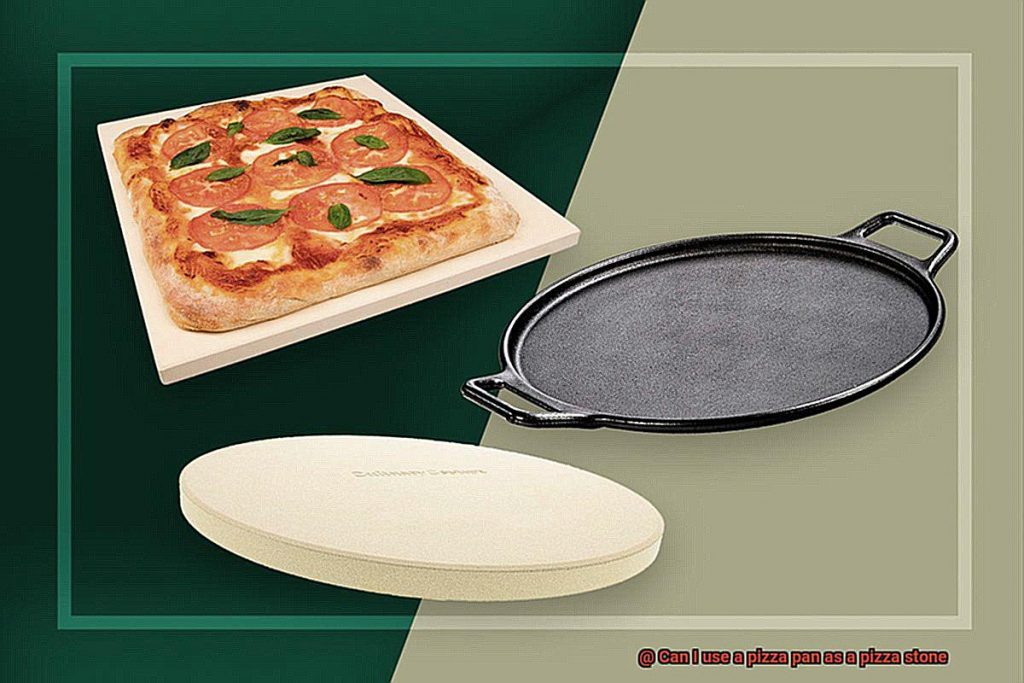Do you consider yourself a pizza aficionado who loves crafting delicious pies from the comfort of your own kitchen? If so, you may have heard that using a pizza stone can help achieve that perfect crispy crust. But what if you don’t have one? Fear not, because there are alternatives, like a trusty pizza pan. The question is: can you really use a pizza pan as a pizza stone?
In this blog post, we’ll explore whether or not a pizza pan can be used as an effective substitute for a pizza stone. We’ll compare and contrast the benefits of each method and give you some insider tips to ensure that your homemade pizzas come out just right.
So if you’re still on the fence about using a pizza pan as a pizza stone, keep reading. By the end of this post, you’ll have all the knowledge and tools necessary to make an informed decision and create mouthwatering homemade pizzas with ease.
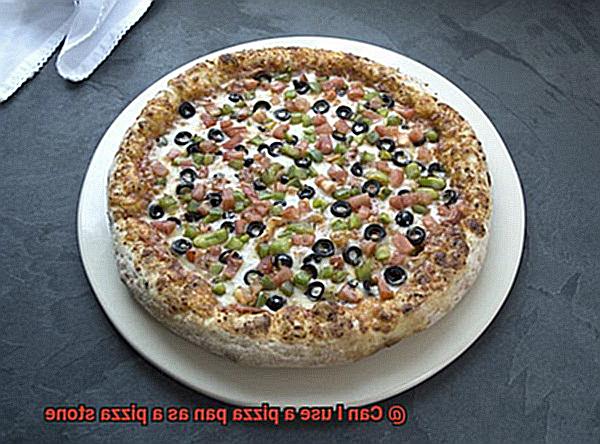
Contents
What is a Pizza Stone?
This circular and heavy slab, made from materials like ceramic, clay, or cordierite, is an essential tool for achieving crispy and evenly cooked pizzas.
Here are some key features of a pizza stone that make it stand out:
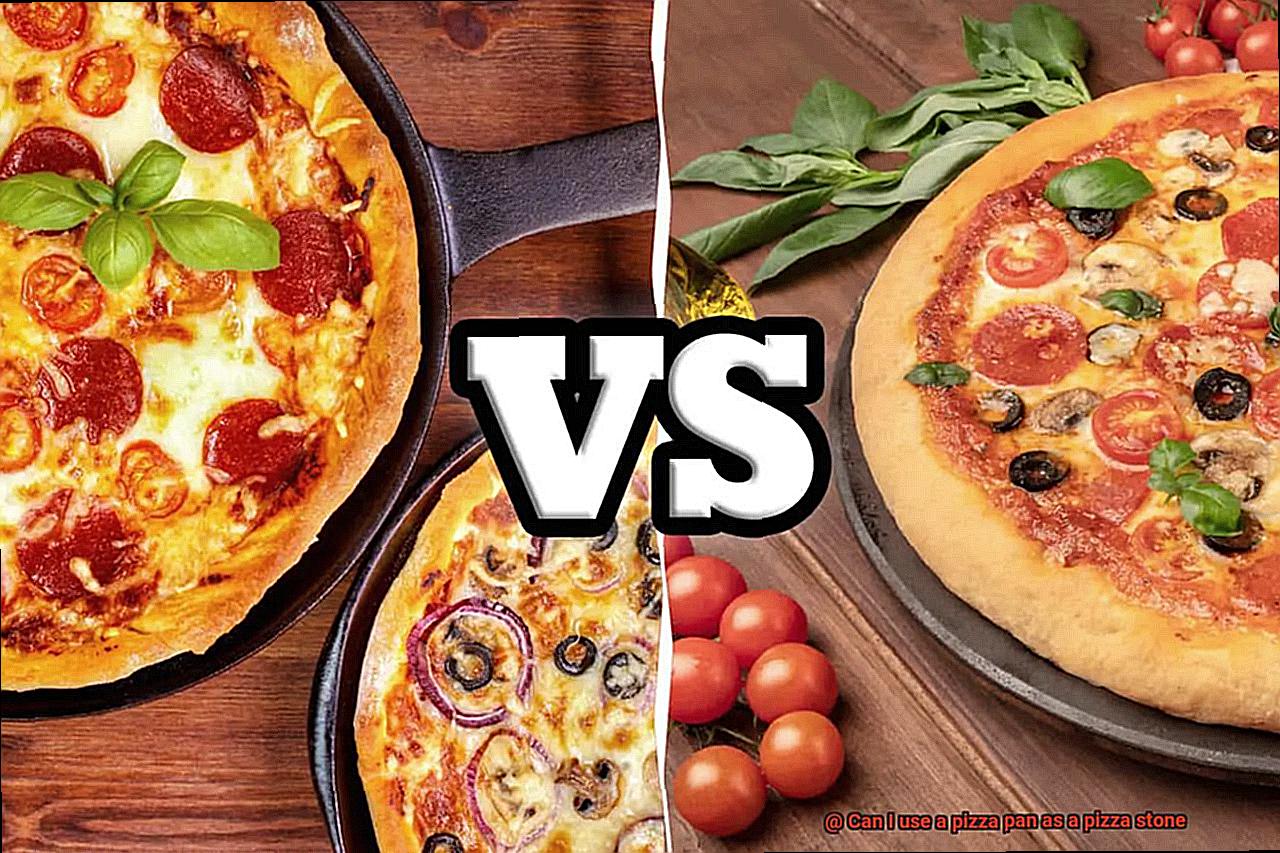
- Comes in different shapes and sizes, but most are round with a diameter of 12-16 inches
- Made from materials that can withstand high temperatures and absorb moisture from the dough
- Designed to distribute heat evenly across the surface to ensure uniform cooking
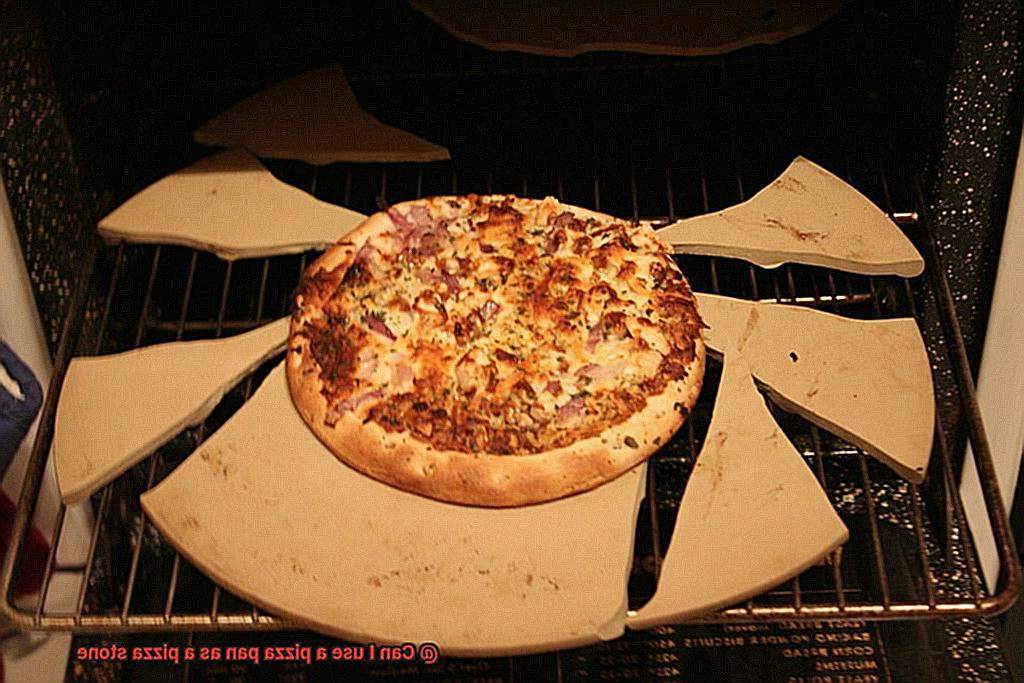
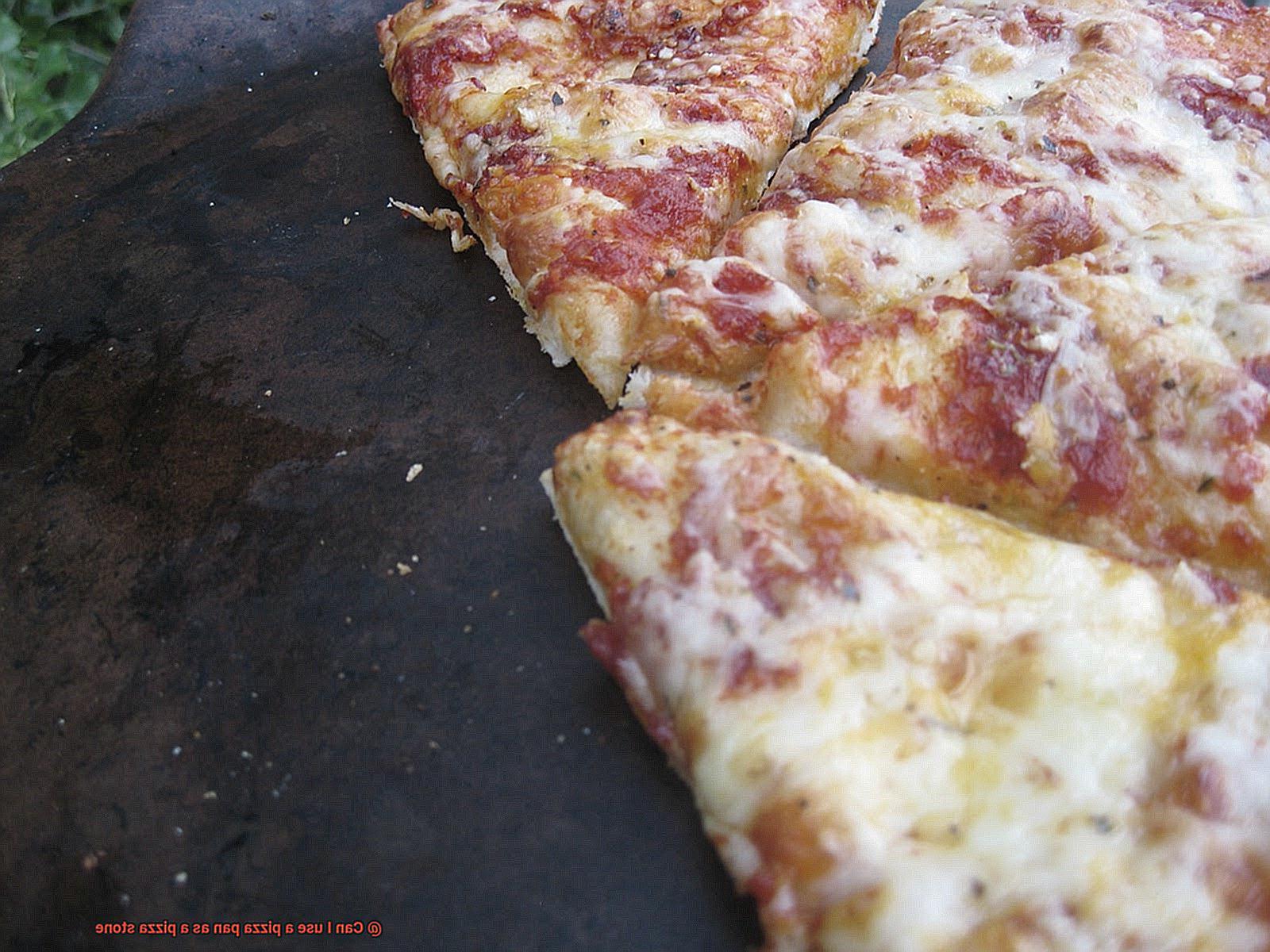
By preheating the pizza stone in the oven, it absorbs heat and transfers it to the dough for even cooking. This results in a perfectly crispy crust that will rival any pizzeria’s offerings. With the right ingredients and technique, anyone can make delicious pizzas at home using a pizza stone.
But what sets a pizza stone apart from other baking tools? Well, for starters, it absorbs moisture from the dough which prevents sogginess and creates a crispy crust. Additionally, its ability to distribute heat evenly across the surface ensures that your pizza cooks uniformly.
While most pizza stones are round, they come in various sizes and can be made from different materials. Some even have handles or raised edges to make it easier to transfer your pizza to and from the oven. When it comes to choosing a pizza stone, it’s important to consider your oven’s size and your personal preferences.
But what if you don’t have a pizza stone? Can you use a pizza pan instead? The answer is yes, but keep in mind that a metal pizza pan does not have the same heat distribution properties as a pizza stone. You may need to adjust your cooking time and temperature to achieve similar results.
Advantages of Using a Pizza Stone
As an expert on this topic, I can confidently say that using a pizza stone has numerous advantages that make it an essential tool for any pizza lover.
Firstly, a pizza stone provides even heating that ensures the entire pizza is cooked to perfection. Its porous and unglazed material absorbs moisture from the dough, creating a crispy crust that is evenly cooked. Plus, the high temperature of the stone caramelizes the sugars in the dough, adding an irresistible flavor to your pizza that will have you coming back for more.
Secondly, a pizza stone retains heat for a longer time than a regular pizza pan. This means your pizza will stay hot and fresh even after it’s out of the oven, allowing you to enjoy every delicious bite without worrying about it getting cold.
Thirdly, a pizza stone is versatile and can be used for cooking other foods like bread, biscuits, and vegetables. This makes it a valuable tool in any kitchen, allowing you to expand your cooking repertoire and experiment with new recipes.
But wait, there’s more. Cleaning a pizza stone is incredibly easy – all it requires is wiping it down with a damp cloth after it has cooled down. No need for scrubbing or harsh chemicals, making it an eco-friendly and efficient tool.
Can You Use a Pizza Pan as a Pizza Stone?
When it comes to making pizza, a pizza stone is a crucial tool. It helps distribute heat evenly and creates that perfect crispy crust that pizza lovers crave. But, what if you don’t have a pizza stone? Can you use a pizza pan instead? The answer is yes, but there are some things to keep in mind.
Pizza pans are typically made of aluminum or steel and are designed to conduct heat quickly, while pizza stones are made of ceramic or cordierite and absorb moisture to create a crisp crust. So, while using a pizza pan as a substitute for a pizza stone isn’t ideal, it can work in a pinch if you take some extra steps to ensure your pizza gets crispy and delicious.
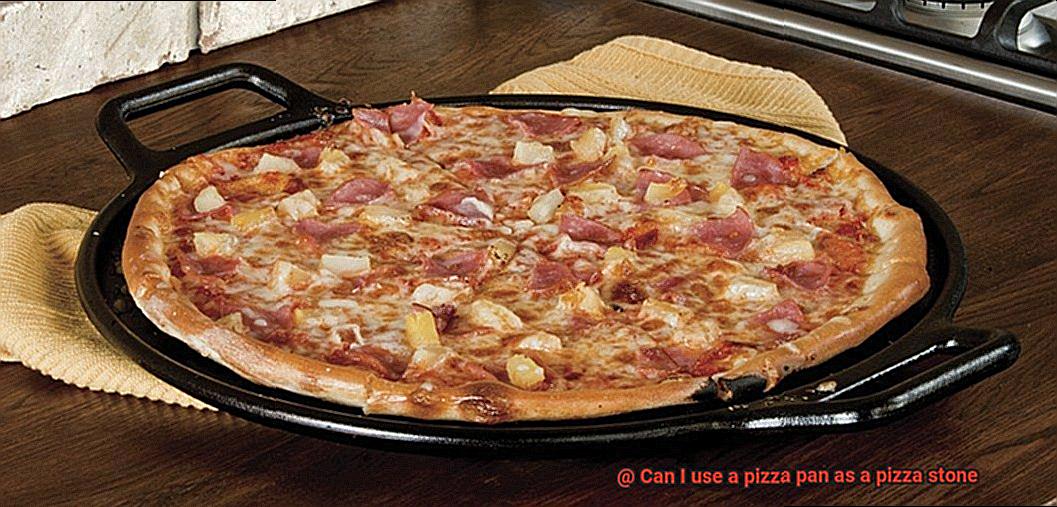
Firstly, preheat your oven to the highest temperature possible for at least 30 minutes before baking your pizza. This will help the pizza pan get hot enough to create that crispy crust you’re after. You can also preheat the pizza pan on the stovetop before transferring it to the oven to help it get even hotter and distribute heat more evenly.
Another tip to prevent dough from sticking to the pizza pan is to use parchment paper underneath your pizza when baking. Not only does this prevent sticking, but it also makes it easier to slide your finished pizza onto a cutting board.
Remember, using a pizza pan instead of a pizza stone requires some extra effort, but it’s worth it for that perfect homemade pizza. By following these tips, you can use your trusty pizza pan as a substitute for a pizza stone and satisfy your craving without having to invest in an expensive piece of equipment.
Preparing the Pizza Pan for Use as a Pizza Stone
A pizza pan can be used as a substitute, but it’s essential to prepare it properly before use.
The first step is crucial: clean the pizza pan thoroughly. Any leftover grease or food particles can negatively affect the taste and texture of your pizza. Use warm soapy water and a sponge or cloth to scrub the pan clean.
Once the pan is clean, dry it completely to prevent any moisture from compromising the crust of your pizza. Then, preheat the pan in the oven to your desired temperature. This ensures that the pan is evenly heated and ready for use.
To prevent sticking, season the pan with oil or flour before placing your pizza dough on it. If you’re using a non-stick pizza pan, be sure to take this step seriously. Additionally, consider lining the pan with parchment paper to make it easier to remove the pizza once it’s cooked.
It’s important to note that using a pizza pan as a substitute for a traditional pizza stone might not produce identical results. However, proper preparation and technique can still yield delicious homemade pizzas with a crispy exterior and a soft interior.
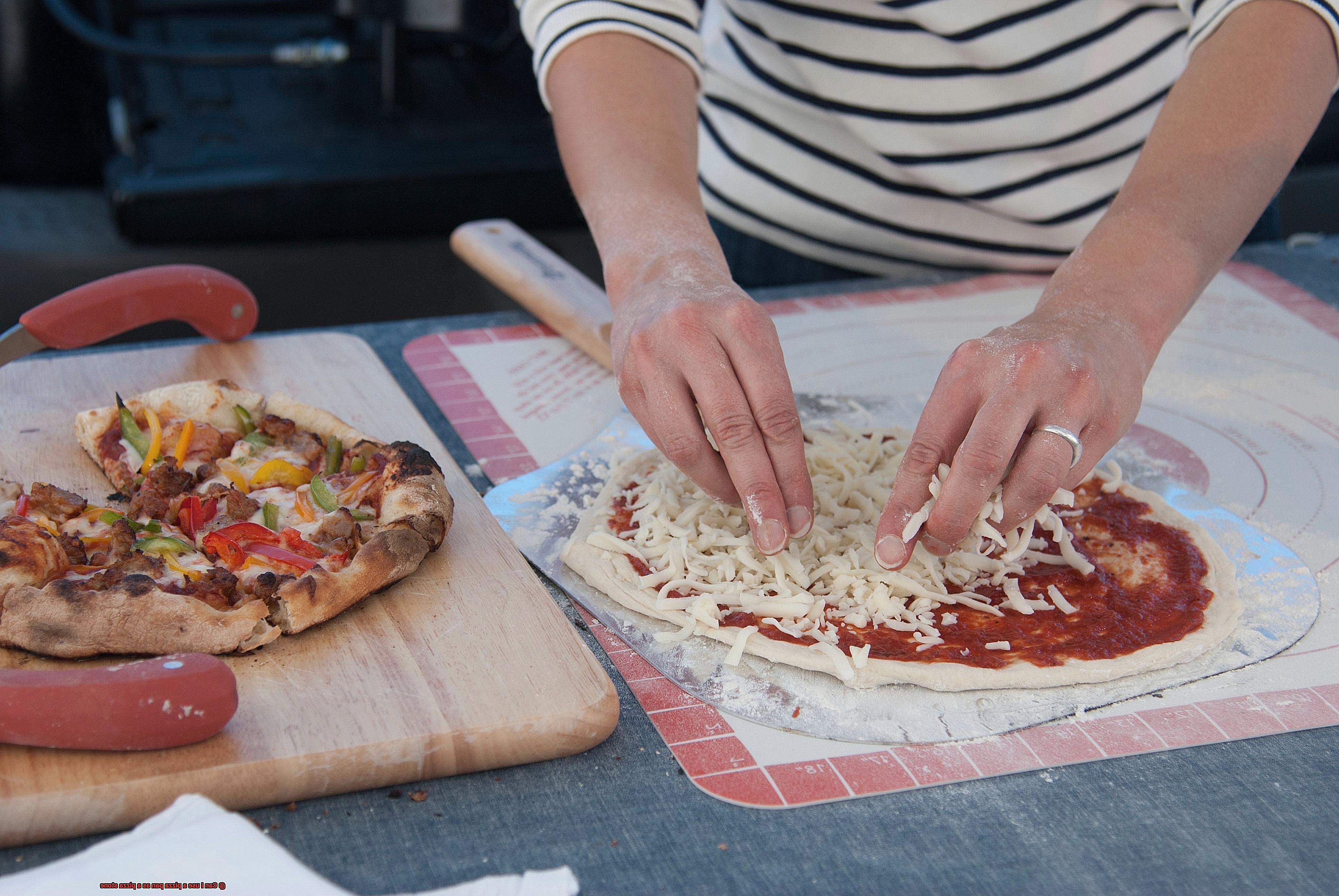
Adjusting Cooking Time and Temperature When Using a Pizza Pan as a Pizza Stone
We’re here to guide you on how to adjust your cooking time and temperature when using a pizza pan as a pizza stone.
First, let’s talk about the main differences between a pizza pan and a pizza stone. A pizza stone is made of porous material that absorbs moisture and distributes heat evenly, while a pizza pan is usually made of metal and doesn’t have the same porous quality. To compensate for this difference, we recommend increasing your oven temperature by 25-50°F and reducing your cooking time by a few minutes. This will help ensure even cooking and prevent burnt or soggy crusts.
But what about crust thickness? With a less porous pan, thicker crusts may not cook evenly. We suggest trying thinner crusts or pre-baking the crust for a few minutes before adding toppings to avoid this issue.
Remember, every oven is different, so keep an eye on your pizza while it’s cooking and make any necessary adjustments to achieve the perfect pie. Experiment with different settings to find the ideal combination for your particular setup.
Alternative Method: Preheating the Pan on the Stove
Look no further than preheating your pizza pan on the stove. This alternative method involves heating the pan on the stove before transferring it to the oven, resulting in a perfectly cooked pie every time.
To preheat your pizza pan on the stove, simply place it on a burner over medium-high heat for about 10 minutes. It’s crucial to ensure that the handle of the pan isn’t touching the burner and that you don’t leave the pan unattended as it heats up. Once the pan is heated, carefully remove it from the stove and place your pizza onto it.
One advantage of using this method is that it can help to create a crispy crust without having to invest in a pizza stone. The heat from the preheated pan helps to cook the bottom of the crust quickly and evenly, resulting in a satisfying texture. However, it’s important to note that this method may not be as effective as using a pizza stone, which is specifically designed to absorb and distribute heat evenly throughout the pizza.
Another potential issue with preheating a pizza pan on the stove is that it may not be suitable for all types of pizza. Thicker pizzas or those with a lot of toppings may not cook as evenly using this method, so it’s important to keep an eye on your pizza during cooking. But don’t worry – with some experimentation, you’ll find the perfect combination for your particular setup.
Disadvantages of Using a Pizza Pan Instead of a Pizza Stone
While using a pizza pan may seem like a quick and easy solution, it comes with significant disadvantages that can ruin your homemade pizza.
Firstly, pizza pans do not distribute heat evenly. As a result, some parts of your pizza may be overcooked while others remain undercooked. This uneven distribution of heat can lead to a disappointing pizza experience and leave you feeling unsatisfied.
Another disadvantage of using a pizza pan is its lack of moisture absorption. When you place your pizza on a pizza pan, the moisture from the dough and toppings accumulates on the surface, making your crust soggy and unappetizing. On the other hand, a pizza stone absorbs excess moisture, resulting in a crispy and delicious crust.
Moreover, most pizza pans are made from materials such as aluminum or non-stick coating, which can release harmful chemicals when exposed to high temperatures. These chemicals can be hazardous to your health and affect the taste of your pizza, leaving an unpleasant aftertaste.
Lastly, using a pizza pan can limit your options for size and shape. Pizza pans usually come in limited sizes and shapes, which can restrict you from making larger or uniquely shaped pizzas according to your preference.
Tips for Getting the Best Results with Your Pizza Pan
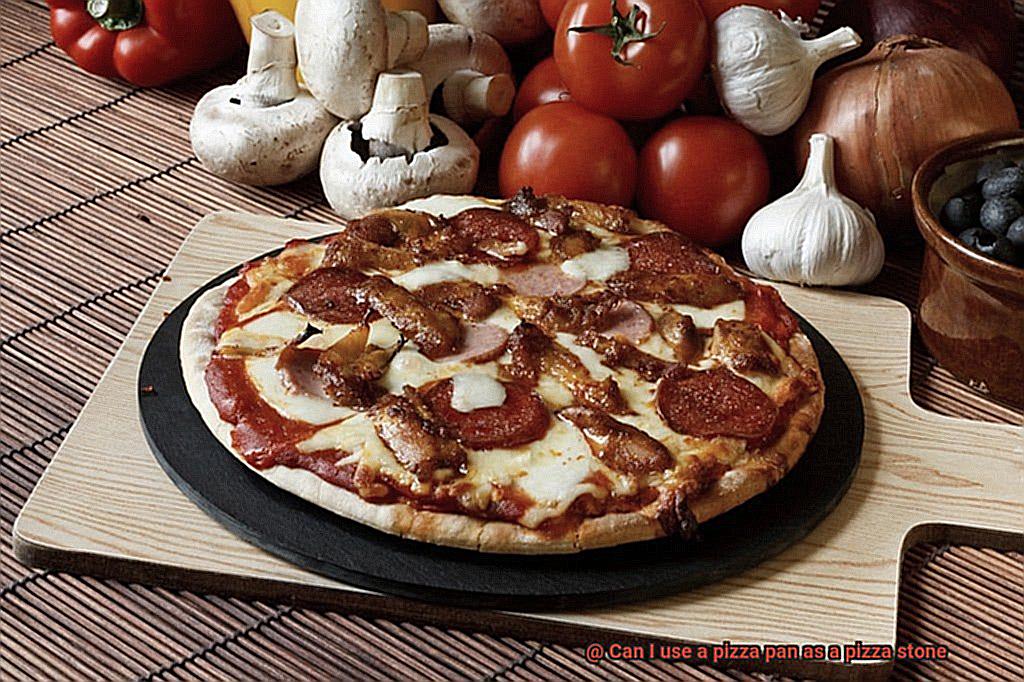
If you’re a pizza lover and want to make homemade pizzas without a pizza stone, you can use a pizza pan instead. However, using a pizza pan requires some adjustments to your cooking time and temperature to ensure that your pizza comes out crispy and delicious. Here are five tips for getting the best results with your pizza pan:
Preheat your oven or grill
The first thing you need to do is preheat your oven or grill to the appropriate temperature before placing your pizza on the pan. This will ensure that the crust cooks evenly and doesn’t become soggy. A preheated oven or grill is essential for achieving a crispy, delicious pizza.
Use a thin crust pizza dough
Using a thin crust pizza dough will allow for the heat to transfer more easily to the toppings and ensure that the crust cooks evenly. A thick crust can take longer to cook, leading to uneven cooking.
Don’t overload your pizza with toppings
While it may be tempting to pile on all your favorite toppings, overloading your pizza with too many toppings can lead to a soggy crust and uneven cooking. Instead, use thinly sliced vegetables and meats as toppings.
Lightly dust your pizza pan
To prevent the dough from sticking, lightly dust your pizza pan with flour or cornmeal before placing the dough on it. This will also add texture to the crust, making it more flavorful.
Let your pizza rest
Once your pizza is cooked, let it rest for a few minutes before slicing and serving. This will allow the cheese and toppings to set and prevent them from sliding off the pizza when you cut into it. Letting your pizza rest will also help it retain its shape, making it easier to handle.
AMmPD_EtUa4″ >
Conclusion
In summary, a pizza stone is a must-have for achieving the perfect crispy crust on your homemade pizzas. But don’t worry if you don’t have one – a pizza pan can be used as a substitute with some adjustments to your cooking process. While it may not produce identical results, you can still create delicious pizzas with a crispy exterior and soft interior.
To use a pizza pan in place of a pizza stone, start by preheating your oven or grill to the appropriate temperature. Use thin crust dough and avoid overloading your pizza with toppings. Lightly dust your pan with flour or cornmeal to prevent sticking and let your pizza rest before slicing and serving.
Although metal pans may not distribute heat as evenly as ceramic or cordierite stones, you can still achieve great results by taking extra steps to ensure your homemade pizzas come out just right. With the right ingredients and techniques, anyone can make mouthwatering pizzas without breaking the bank on expensive equipment.

